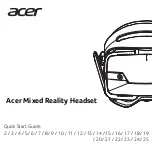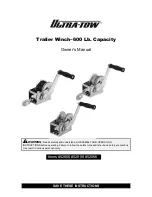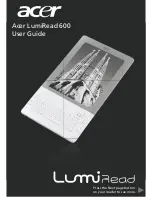
2
Remove the 4 bolts (key 11) that secure the bowl to the
•
base.
Rotate the bowl 180° and re-secure it, using the nylon
•
washers (key 14) to protect the ceramic from the
stainless steel washers and nuts (key 13,12).
Rotate the pump assembly 180° and re-secure it.
•
Rotate the push-fit intake elbow (key 6) 180° and refit
•
the hose between the pump and the bowl.
2. Location
Select a location that will give sufficient clearance all
•
round and above the toilet. Ensure that there is room to
operate the pump and that there is access to the drain
plug at the end of the base.
The mounting surface must be flat, rigid and strong
•
enough to support a man's weight and should be at least
50mm (2") wider and 50mm (2") deeper than the base of
the toilet.
You will need sufficient clearance below the mounting
•
surface to be able to secure the mounting bolts.
The seat and lid should be able to swing up and over at
•
least 110°, so that they will not fall forward when the
craft heels or pitches. When they are swung up they
must be supported so that the hinges are not strained
3. Mounting
YOU WILL need:
❏
4 x 8mm (5/16") diameter stainless steel bolts of length
to suit the thickness of the mounting surface.
❏
4 stainless steel nuts, preferably self-locking. If you do
not use self-locking nuts you will need some nut-locking
compound.
❏
8 large stainless steel washers not more than 21mm
(13/16") diameter.
❏
A small tube of white silicone sealant.
Offer up the toilet in the selected position and, using the
•
holes in the base as a guide, mark the positions for the 4
bolt holes on the mounting surface. Remove the toilet
and drill 4 vertical holes of 9mm diameter through the
mounting surface.
Apply a bead of white silicone sealant to the outer rim of
•
the bottom base.
Bolt down the toilet and tighten the fastenings securely. If
•
you are not using self-locking nuts, use nut-locking
compound.
4. Through Hull Fittings
YOU WILL need:
❏
19mm (3/4") bore seacock for the flushing water inlet,
and, if you are discharging the waste overboard, a 38
mm (11/2") bore seacock for the waste outlet.
Follow the seacock manufacturer's own instructions
•
concerning materials and methods of installation.
Ensure the inlet seacock is positioned where it will be
•
below the waterline at all times when the craft is
underway, and also ensure that any outlet seacock is
both aft of, and higher than, the inlet seacock.
HAZARD RISK - Through Hull Fittings
If the installation of the toilet results in it being connected to
ANY through-hull fitting that may possibly be below the
waterline at ANY time, whether when the craft is at rest,
underway and heeling or rolling or pitching, you must install
the toilet in accordance with these Installation Instructions. If
you do not, water may flood in, causing the craft to sink, which
may result in loss of life.
FOLLOW THESE INSTRUCTIONS!
HAZARD RISK - Accidental Damage
If the toilet is connected to ANY through-hull fittings and if the
toilet or pipework is damaged, water may flood in causing the
craft to sink, which may result in loss of life.
Therefore, if you are making connections between the toilet
and ANY through-hull fittings that may possibly be below the
waterline at ANY time, full bore seacocks MUST be fitted to
those hull fittings, to allow them to be shut off.
The seacocks MUST also be positioned where they are easily
accessible to all users of the toilet. If, for any reason, it is not
possible to do this, then secondary full bore marine quality
valves MUST be fitted to the hoses where they are easily
accessible.
USE SEACOCKS!
CAUTION: Use lever operated, full bore marine
seacocks and valves. The use of screw-down
gate valves is not recommended.
5. Pipework - selection of correct method
YOU MUST select the correct method for the inlet pipework
from 2 options and for the outlet pipework from 4 options,
according to whether the toilet is above or below the waterline,
and to whether it discharges the waste overboard or into an
on-board holding tank.
HAZARD RISK - Pipework Becomes Loose
If the toilet is connected to ANY through-hull fittings and if the
pipework becomes disconnected, either from a through-hull
fitting or seacock, or from the toilet or any secondary valve,
water may flood in and may cause the craft to sink, which may
result in loss of life.
Therefore the ends of ALL flexible hoses fitted directly or
indirectly between the toilet and ANY through-hull fitting that
may possibly be below the waterline at ANY time, MUST be
secured to the hose tails to which they are connected, using
two stainless steel worm-drive hose clips.
USE HOSE CLIPS!
5.1 Pipework - General instructions for all options
YOU WILL need:
❏
Spiral reinforced smooth bore flexible hoses for both the
19mm (3/4") id inlet and the 38mm (11/2") id outlet
pipework
❏
Two stainless steel worm-drive hose clips for every hose
tail connection (4, 6 or 8).



























